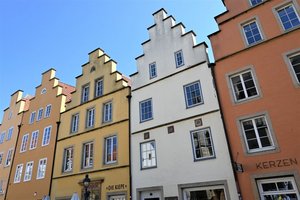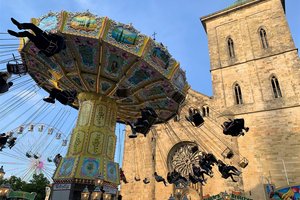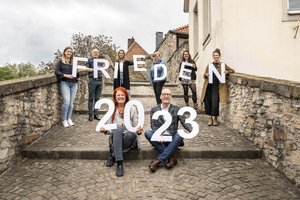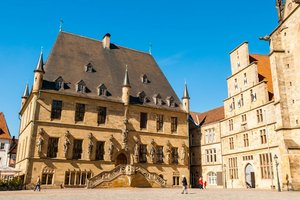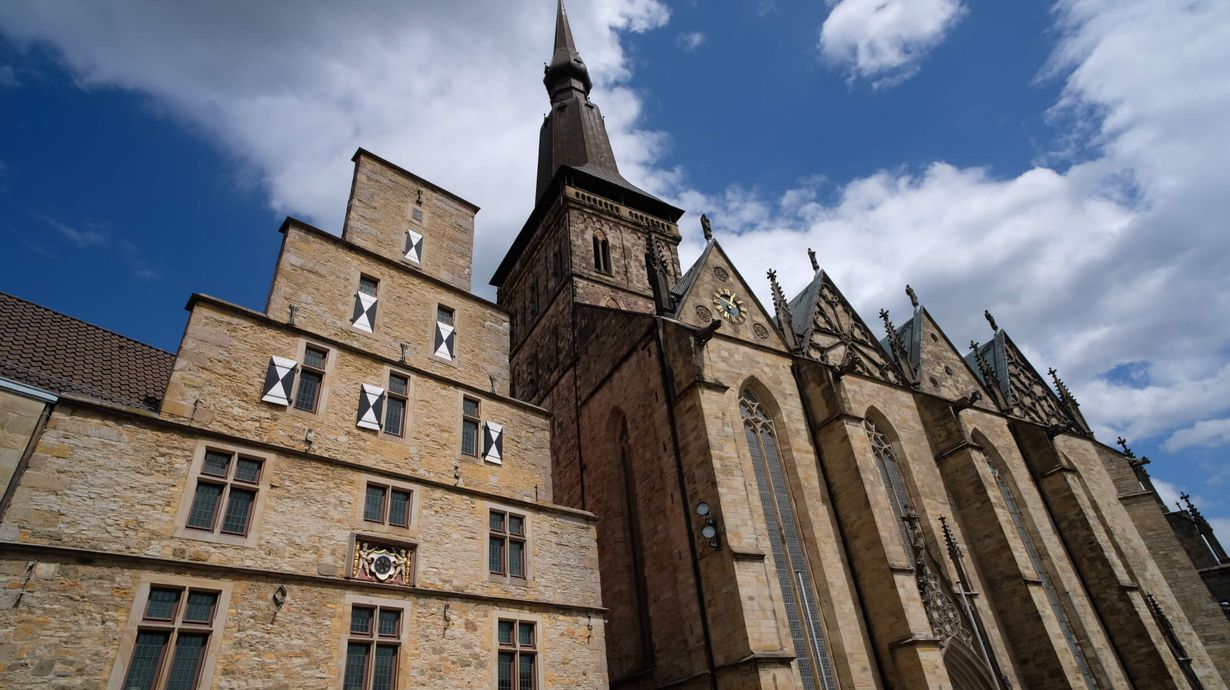The impressive Evangelical Lutheran parish, civic and market church of St. Mary's soars above the Historic Market Square. The construction of the Gothic hall church began in the 13th century and was completed around 1430/40. This construction was preceded by a Romanesque predecessor church, which was already mentioned in documents in 1177. The church suffered heavy damage from incendiary bombs during the Second World War, but was rebuilt in the post-war period. In the course of this, excavations were carried out on the grounds of St. Mary's from 1950 onwards to investigate the building’s history. Further archaeological investigations were carried out in 1987-1989 and 1989-1992. The extensive excavations provided evidence of the existence of at least three predecessor buildings from the second half of the 10th century onwards.
The church tower, which is open to the public, offers an impressive view over the whole town. Passing the church bells and through medieval stone passages, you climb to the viewing platform 50 metres above the ground.
Together with Osnabrück Cathedral, St. Catherine’s Church and St. John’s Church, St. Mary’s Church is one of the four medieval churches that surround the city centre.
Structural features
The oldest part of the building is the church tower. With a height of 80 metres, it is the second highest in Osnabrück (after the tower of St. Catherine's Church). Structural elements such as the round Romanesque arch at the transition between the tower and the nave bear witness to its almost 1000-year history.
Inside the church, above the altar, is the city's seal and coat of arms: the Osnabrück wheel.
A total of four portals lead into the three-nave hall church with its arcades and ribbed vaulting. The main entrance to St. Mary's, the so-called bridal portal on the south side of the church, is particularly striking. The figures on the right and left represent the wise and foolish virgins. In the arch of the portal, the coronation of Mary is depicted. Both elements are 19th century reproductions, the originals can be seen in the Museum of Cultural History.
Characteristic of St Mary's Church are the four gables decorated with tracery and the large lancet windows. But the Gothic buttresses and arches, the pinnacles, gargoyles and balustrades that dominate the choir area also give St. Mary's a dynamic and lively effect.
The furnishings of the church
Some of the furnishings of St. Mary's have been preserved for centuries.
One of the oldest pieces is the Triumphal Cross from the end of the 13th century. This symbolises the triumph of the resurrection over death. While the body of the crucified Jesus is dead, he still appears to be alive. This depiction represents a difference from the crosses of a suffering Jesus that were common in later centuries. Originally, the Jesus figure of the Triumphal Cross of St. Mary's had closed eyes. As a result of a renovation in the 18th century, the figure was painted with open eyes (presumably by mistake).
The main altar from 1510 corresponds in its construction to the model of the so-called "Antwerp altar". Craftsmen from the now Belgian city designed the principle of a modular plug-in box system consisting of individual and combinable figures. These were pre-produced in Antwerp, then shipped and assembled on site in the respective churches. This option made the purchase of altars more affordable and avoided expensive and lengthy custom-made pieces. The Osnabrück altar with its figures, fashionably dressed in the spirit of the time, tells the story of Jesus up to his ascension and the outpouring of the Holy Spirit at Pentecost.
Other historical furnishings include the figure of "Mary on the Crescent Moon" (1520), the epitaphs on the floor in the choir and on the walls (16th and 17th centuries), the Romanesque crucifixion group (mid-13th century) and the baptismal font (1560). Modern elements such as the globe chandelier and the communion table (1995) are also part of the present inventory of the church.
The organ was built in 1967 by the Dutch organ-building firm Flentrop and restored in 1998 and 2013. The action and stop action are mechanical, the Brustwerk (chest division) is equipped with a swell mechanism. The organ has 47 stops on four manual movements and pedal.
Significance as a market and citizens' church
The first building of St. Mary's Church was not built as a collegiate church, but as a merchant's and citizen’s church. In 1218 it was attached to the cathedral chapter as a citizen's and council church. The chapter decided on the appointment of the parish priests and the parish assets were also transferred to the cathedral. However, the church councillors of St. Mary's administered the "God's house assets" for the upkeep of the church, which meant that bourgeois endowment money remained with the congregation. The noble citizens of Osnabrück preferred to use the church as a place of burial. The construction of the hall choir in the 15th century turned out to be a political dispute between the citizens and Bishop Erich von Hoya. The bishop prevented a high hall choir from being built, as he saw it as competition with the cathedral. In 1543, the Reformation was introduced by the town council with the consent of the Reformation-minded Bishop Franz von Waldeck. Apart from minor interruptions, St Mary's Church had been Lutheran ever since and became a parish church. In addition, the city had succeeded in asserting its right to fill the parishes against the cathedral chapter. The new town council was introduced in St. Mary's with a solemn service.
The bells of the church fulfilled a special function for the people of Osnabrück in the early modern period. For example, the storm bell, which was used until the 17th century, could announce both a calamity ("storm ringing" on one side only) and the new election of the councillors (on Handgiftentag “handshake day” by gentle striking on both sides).
St. Mary's and the negotiations of the Peace of Westphalia
When the peace negotiations began in Osnabrück in 1643, St. Mary's Church served as a secret negotiating venue for the Swedes and Danes. The envoys met here for confidential talks to avoid observation by spies. The noble Swedish society in the city attended services in St. Mary's. In 1646 Anna Margaretha Sture, the wife of the Swedish envoy Johan Oxenstierna, died in Osnabrück. She was temporarily buried in St. Mary's, as indicated by a memorial plaque in the choir area.
When the Peace of Westphalia was proclaimed in Osnabrück on 25 October 1648, wind players on the church tower played chorales in all directions, including the "Osnabrück Peace Song". With the "Capitulatio perpetua Osnabrugensis", the Lutheran confession was established for St. Mary's.
Damage of the Second World War and restoration
On the evening of 13 September 1944, Osnabrück experienced a devastating bombing raid by Allied troops, which also hit St. Mary’s Church. In just 14 minutes, 1263 tons of explosives fell on the city. The tower and the nave of the church were completely burnt down. A huge hole appeared in the outer wall of the church. After being temporarily put to further use, the church was closed and renovated for four years. The windows, which had also been destroyed during the war, were replaced by purely functional windows. Only in the course of the renovation in the 1980s was it decided to install at least one truly artistically designed window. Today, two windows designed by the famous glass artist Johannes Schreiter in 1992 and 2016 can be found in St. Mary's Church. With these, the artist and the church want to encourage dialogues of different natures.
At a glance
| Opening times |
Office hours:
Tuesday, Wednesday and Friday: 9 a.m. - 12 p.m.
Thursday: 9 - 12 a.m. and 4 - 6 p.m. |

